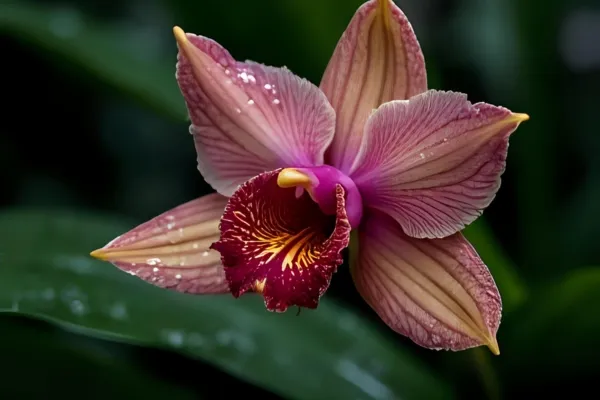Did you know that 85% of orchid cultivation failures stem from incorrect humidity management? This startling statistic from the American Orchid Society reveals why so many passionate growers struggle despite their best intentions. While orchids captivate us with their exotic beauty and intricate blooms, these magnificent plants demand precise environmental conditions that mirror their natural tropical habitats.
The problem is clear: Most indoor environments maintain only 30-40% relative humidity, while orchids typically require 50-80% to truly thrive. This dramatic gap creates stress, stunted growth, bud blast, and eventual plant decline. Many orchid enthusiasts find themselves caught in a frustrating cycle of trial and error, watching their prized specimens suffer despite regular watering and adequate lighting.
Here’s what you’ll master: By the end of this comprehensive guide, you’ll possess the expert knowledge to create perfect humidity conditions for any orchid variety. You’ll understand the science behind humidity requirements, learn professional measurement techniques, and implement proven methods that successful commercial growers use daily. Most importantly, you’ll transform your growing environment into a thriving orchid paradise where your plants not only survive but flourish with abundant, long-lasting blooms.
Understanding Orchid Humidity Requirements
Why Humidity Matters for Orchid Health
Humidity directly impacts every aspect of orchid physiology, from nutrient absorption to photosynthesis efficiency. Research from Cornell University’s Department of Horticulture demonstrates that proper humidity levels enhance gas exchange through stomatal function, leading to improved growth rates and bloom production.
When humidity drops below optimal levels, orchids respond by closing their stomata to prevent excessive water loss. This protective mechanism severely limits carbon dioxide intake, effectively starving the plant of essential resources needed for photosynthesis. The result? Weakened plants that struggle to produce energy, develop properly, or defend against common diseases.
Conversely, adequate humidity maintains open stomatal pores, allowing for efficient gas exchange while supporting the plant’s natural cooling mechanisms. This creates the foundation for robust root development, healthy leaf growth, and spectacular flowering cycles that orchid enthusiasts cherish.
Natural Habitat vs. Indoor Conditions
Most cultivated orchids originate from tropical and subtropical regions where relative humidity consistently ranges between 60-90%. In these natural environments, dense forest canopies, frequent rainfall, and abundant vegetation create stable moisture levels throughout the day.
Indoor conditions present stark contrasts to these native habitats. Heating and cooling systems actively remove moisture from the air, while sealed environments lack the natural evaporation cycles that maintain consistent humidity. During winter months, indoor humidity can plummet to desert-like levels of 10-20%, creating extreme stress for tropical orchids.
Understanding this fundamental disconnect explains why successful orchid cultivation requires intentional humidity management. By recreating the moisture conditions of their natural habitats, we provide orchids with the environmental stability they need to express their full genetic potential.
Optimal Humidity Levels for Different Orchid Types
Phalaenopsis Humidity Needs
Phalaenopsis orchids, commonly known as moth orchids, thrive in 60-70% relative humidity. These popular beginner-friendly orchids tolerate slight humidity fluctuations better than many other varieties, making them excellent choices for indoor cultivation.
Research from the University of Florida’s Institute of Food and Agricultural Sciences indicates that Phalaenopsis orchids maintain optimal photosynthetic rates when humidity remains consistently above 55%. Below this threshold, these plants experience measurable stress responses, including reduced growth rates and delayed flowering.
During active growing seasons, maintaining humidity in the upper range (65-70%) promotes vigorous vegetative growth and robust root development. During dormant periods, slightly lower humidity levels (55-60%) can actually encourage flower spike formation.
Cattleya and Dendrobium Requirements
Cattleya orchids demand higher humidity levels, typically 65-80% relative humidity for optimal performance. These spectacular orchids evolved in cloud forests where consistent moisture saturation supports their large, showy blooms and substantial pseudobulbs.
Dendrobium species present more varied requirements depending on their specific origins. Most popular varieties thrive in 60-75% humidity, with deciduous types tolerating lower levels during their dormant periods.
The key difference lies in these orchids’ growth patterns. Cattleyas and Dendrobiums often experience distinct growing and dormant seasons, requiring humidity adjustments that mirror natural rainfall patterns in their native habitats.
Terrestrial vs. Epiphytic Orchid Differences
Epiphytic orchids, which naturally grow on trees, require higher ambient humidity (65-80%) compared to their terrestrial counterparts. These air-dwelling plants depend entirely on atmospheric moisture for hydration between rainfall events.
Terrestrial orchids, growing in forest floor conditions, typically thrive in 55-65% humidity. Their root systems access soil moisture, making them less dependent on atmospheric water vapor for survival.
This distinction becomes crucial when designing growing environments for mixed orchid collections. Epiphytic varieties benefit from increased air circulation combined with higher humidity, while terrestrial orchids prefer more stable, moderate moisture levels.
How to Measure and Monitor Humidity Levels
Essential Tools and Equipment
Accurate humidity measurement forms the foundation of successful orchid cultivation. Professional growers rely on digital hygrometers equipped with min/max memory functions to track humidity fluctuations throughout 24-hour cycles.
The most reliable instruments feature calibrated sensors with accuracy ratings of ±3% or better. Brands like AcuRite, ThermoPro, and Ambient Weather produce affordable, laboratory-grade hygrometers suitable for orchid cultivation.
For comprehensive monitoring, consider investing in data logging hygrometers that record humidity readings over extended periods. These devices reveal patterns invisible during casual observation, enabling precise adjustments to your humidity management strategy.
Digital vs. Analog Hygrometers
Digital hygrometers offer superior accuracy and convenience compared to traditional analog models. Modern digital units provide instant readings, memory functions, and often include temperature measurements for complete environmental monitoring.
Analog hygrometers, while charming and budget-friendly, suffer from calibration drift and limited precision. Hair hygrometers, common in analog designs, can deviate by 10-15% over time, making them unsuitable for precise orchid cultivation.
Professional orchid growers universally prefer digital instruments for their reliability and additional features. Many digital models include programmable alerts that notify you when humidity levels drift outside optimal ranges.
Placement and Reading Techniques
Strategic hygrometer placement ensures accurate readings that reflect actual growing conditions. Position instruments at plant canopy level, approximately 6-12 inches from your orchids, avoiding direct contact with leaves or growing media.
Avoid placing hygrometers near heating vents, air conditioning units, or windows where readings might be skewed by environmental factors unrelated to your orchid microclimate. Multiple hygrometers throughout your growing area provide comprehensive coverage for larger collections.
Take readings at consistent times daily, preferably morning and evening, to establish baseline patterns. Record these measurements in a growing journal to identify trends and seasonal variations affecting your orchid environment.
Proven Methods to Increase Orchid Humidity
Humidity Trays and Pebble Methods
Humidity trays represent the most popular and effective method for increasing localized moisture levels around orchid collections. These simple devices create beneficial microclimates through controlled evaporation without risking root rot from standing water.
Construction and setup: Use waterproof trays filled with expanded clay pebbles, decorative stones, or specialized humidity crystals. Add water until it reaches approximately 3/4 of the pebble depth, ensuring orchid pots never sit directly in standing water.
Place orchid containers on top of the pebble surface, allowing natural evaporation to increase surrounding humidity by 10-20%. This method works particularly well for windowsill growing and small collections where room-wide humidity control isn’t practical.
Room Humidifiers for Orchid Collections
Ultrasonic humidifiers provide precise humidity control for dedicated orchid growing areas. These devices atomize water into fine particles that quickly integrate with ambient air, raising humidity levels efficiently without creating excessive moisture buildup.
Selection criteria: Choose humidifiers with adjustable output controls, built-in hygrometers, and automatic shut-off features. Tank capacity should match your space requirements – larger rooms need units capable of producing 300-500 ml/hour output.
Cool-mist humidifiers work best for orchid applications, avoiding the temperature fluctuations associated with warm-mist models. Position units to provide gentle air circulation without creating direct drafts on sensitive orchid foliage.
Grouping and Microclimate Creation
Strategic plant grouping naturally increases humidity through collective transpiration and reduced air circulation. This technique, known as microclimate creation, allows orchid collections to support each other’s environmental needs.
Arrange orchids in clusters with taller plants providing wind protection for smaller varieties. Leave adequate spacing for air circulation while maintaining close enough proximity for transpiration benefits. This method can increase local humidity by 5-15% compared to isolated plant placement.
Combine grouping with humidity trays and strategically placed water features for maximum effectiveness. Small fountains or water bowls enhance evaporation while adding aesthetic appeal to your orchid display.
Common Humidity Mistakes and Solutions
Overhumidification Problems
Excessive humidity creates dangerous conditions that promote fungal diseases, bacterial infections, and pest infestations. Humidity levels consistently above 80% without adequate air circulation become breeding grounds for crown rot, black rot, and other devastating orchid diseases.
Warning signs: Persistent water droplets on leaves, musty odors, soft or discolored pseudobulbs, and rapidly spreading dark spots indicate overhumidification problems requiring immediate attention.
Solutions: Increase air circulation with fans, reduce humidity sources temporarily, and ensure growing areas have adequate ventilation. Remove affected plant material immediately and treat remaining healthy tissue with appropriate fungicides.
Seasonal Humidity Adjustments
Seasonal changes dramatically impact indoor humidity levels, requiring proactive adjustments to maintain optimal orchid growing conditions. Winter heating systems can reduce humidity to critically low levels, while summer air conditioning creates different challenges.
Winter strategies: Increase humidifier output, add additional humidity trays, and group plants more closely for collective transpiration benefits. Monitor heating vents and radiators that create localized dry zones harmful to orchid health.
Summer approaches: Reduce humidity sources if air conditioning creates overly dry conditions, or supplement with targeted humidification if natural humidity becomes excessive. Maintain air circulation to prevent stagnant, overly moist conditions.
Troubleshooting Low Humidity Issues
Persistent low humidity despite multiple intervention attempts often indicates systemic environmental problems requiring comprehensive solutions. Common culprits include inadequate room sealing, excessive ventilation, or insufficient humidification capacity for space size.
Diagnostic steps: Check for air leaks around windows, doors, and ventilation systems. Measure actual room volume to ensure humidifier capacity matches space requirements. Monitor humidity sources for proper function and adequate water supplies.
Advanced solutions: Install whole-room humidification systems for serious collections, create sealed growing environments using glass cases or terrariums, or relocate orchids to naturally more humid areas like bathrooms with adequate lighting.
Conclusion
Mastering orchid humidity requirements transforms challenging cultivation into rewarding success. The key principles we’ve explored – understanding species-specific needs, accurate monitoring, and implementing appropriate humidity enhancement methods – provide the foundation for thriving orchid collections.
Remember that consistency matters more than perfection. Stable humidity levels within optimal ranges produce better results than fluctuating conditions that stress plants despite occasionally reaching ideal measurements. Your orchids will reward proper humidity management with robust growth, abundant blooms, and years of spectacular beauty.
As climate control technology continues advancing, new tools and techniques will emerge to make orchid cultivation even more accessible. However, the fundamental principles of humidity management remain constant: observe your plants, measure carefully, and adjust thoughtfully based on their responses.
Start implementing these humidity strategies gradually, monitoring your orchids’ responses and adjusting techniques based on their specific needs and your growing environment. With patience and attention to detail, you’ll create the perfect moisture conditions for your orchid collection to flourish.
Frequently Asked Questions
How quickly should I expect to see improvements after adjusting humidity levels?
Orchids typically respond to improved humidity within 2-4 weeks. New root growth and improved leaf turgor are usually the first positive signs, followed by enhanced overall vigor and eventual flowering improvements.
Can I use a bathroom for growing orchids if it has adequate light?
Yes, bathrooms often provide ideal humidity levels for orchids. Ensure adequate ventilation to prevent stagnant air and supplement natural light with grow lights if necessary.
What’s the minimum humidity level orchids can tolerate short-term?
What’s the minimum humidity level orchids can tolerate short-term?
Do orchid humidity needs change during flowering?
Flowering orchids benefit from slightly higher humidity (5-10% increase) to support bud development and extend bloom longevity. However, avoid excessive levels that might promote fungal problems on flowers.
Should I mist my orchids directly to increase humidity?
Direct misting isn’t recommended as it can promote fungal diseases. Focus on increasing ambient humidity through trays, humidifiers, and environmental modifications instead.




